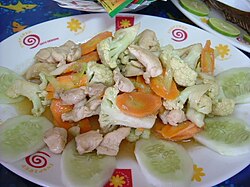This article includes a list of references, related reading, or external links, but its sources remain unclear because it lacks inline citations .(April 2024) |

The Eurasian cuisine of Malaysia and Singapore is a type of fusion cuisine.
This article includes a list of references, related reading, or external links, but its sources remain unclear because it lacks inline citations .(April 2024) |

The Eurasian cuisine of Malaysia and Singapore is a type of fusion cuisine.
In general, Eurasians are people of any mixed European and Asian ancestry. However, if referring to Eurasian cuisine, usually the amalgamation of Portuguese, Dutch, British, Chinese, Malay, and also Indian and Peranakan influences is meant. [1] [2] Within this cuisine, ingredients in European dishes are replaced or complemented by Asian ingredients. Conversely, European ingredients are used in Asian dishes. [2] The cuisine dates to the 16th century. [2]
For example, cream in European recipes is replaced by coconut cream and dried Chinese sausage (lap cheong) is used instead of chorizo. Also, the use of soy sauce, chilli and ginger is used interchangeably with vinegar, mustard and Worcestershire sauce.
The word Eurasian is a portmanteau of European and Asian. [2] There is no clear definition of what can be specified as Eurasian cuisine. It often includes ingredients from Dutch, British, Portuguese, Indian, Chinese cuisines as well as Malay. [3] Some dishes are also found in other cuisines. [2] By local adaptation(s), or by its ubiquitous presence within the Eurasian community, a dish is sometimes considered "Eurasian".


A formal Eurasian dinner will include a half dozen or more dishes. [3] Typically the main meal is presented together and served with rice. [3]